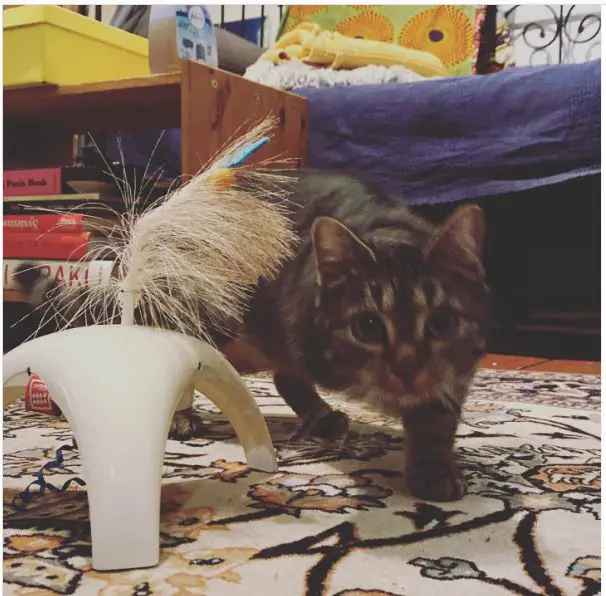Cats are beloved pets that bring joy and companionship to their owners, but their scratching behavior can often cause damage to carpets and furniture. Understanding why cats scratch carpets is crucial for cat owners as it can help them prevent or manage this behavior.
It is important to recognize that scratching is a natural instinct for cats and not a sign of bad behavior. By understanding the biological and behavioral reasons for scratching, cat owners can provide their pets with the appropriate scratching surfaces and address any underlying issues that may be causing them to scratch carpets.
By learning how to protect carpets and furniture, and alternative solutions, cat owners can enjoy a happy and healthy relationship with their feline friends without sacrificing their home’s interior.

Reasons why Cats Scratch Carpet
1. Territorial Marking
Territorial marking is one of the primary biological reasons that cats scratch carpets. Cats have scent glands located in their paws, which they use to mark their territory by leaving their scent behind.
Scratching is a way for cats to deposit their scent and communicate with other cats in the area. This is particularly important for outdoor cats as it helps them establish their territory and protect it from other cats.
But even indoor cats may feel the urge to establish their territory and will mark it with their scent. Scratching carpets and furniture is an easy way for them to do so, as it allows them to leave their scent in a prominent location.
2. Stretching Muscles
Scratching is not only a territorial marking behavior, but it also serves as a way for cats to stretch and flex their muscles.
Cats have a highly developed skeletal and muscular system, and they need to keep it in good condition. Scratching allows cats to stretch their muscles and tendons in their legs, shoulders, and back, which is essential for maintaining flexibility, balance, and coordination.
This behavior is similar to stretching and flexing that humans do after a workout or a long period of inactivity.
Scratching also provides cats with a form of physical exercise, which is especially helpful to indoor cats who may not have the opportunity to engage in as much physical activity as outdoor cats.
3. Exercise and Play
Exercise and play are essential for a cat’s physical and mental well-being. Cats, like all animals, have a natural instinct to move and engage in physical activity.
In the wild, cats would spend most of their time hunting, climbing, and exploring. However, domestic cats, especially indoor cats, may not have the opportunity to engage in as much physical activity as outdoor cats.
4. Stress relief
Stress relief is another behavioral reason that cats may scratch carpets. Cats, like all animals, can experience stress from various sources such as changes in their environment, lack of social interaction, or a change in routine.
When cats are stressed, they may engage in behaviors such as scratching carpets as a form of self-soothing. The act of scratching releases endorphins, which are chemicals in the brain that can help reduce stress and improve mood. Furthermore, the physical act of scratching can also help cats release pent-up energy and tension.
Related: Is carpet bad for your health? Harmful Gases produced by carpets
How to Stop your Cat from Scratching Your Carpet
1. Providing appropriate scratching surfaces
Providing appropriate scratching surfaces is one of the most effective ways to prevent cats from scratching carpets and furniture. Scratching posts, mats, and boards are specifically designed for cats to scratch and can be made from various materials such as sisal rope, carpet, or cardboard.
Choose scratching surfaces that are sturdy and tall enough for cats to stretch out fully while scratching. Also, providing multiple scratching surfaces in various locations around the house can also be beneficial as cats may have different preferences for the type of surface they like to scratch.
Place scratching surfaces in areas where cats like to scratch. Cats often like to scratch near their sleeping area or in front of a window, so placing scratching surfaces in those areas can encourage them to use them instead of carpets and furniture.
It can also be beneficial to place scratching surfaces in areas where cats spend a lot of time to increase the likelihood of them using them.
It’s also worth noting that cats may prefer different types of scratching surfaces depending on their age, breed, or personal preference. Some cats may prefer vertical scratching posts while others may prefer horizontal scratching mats.
Experimenting with different types and textures of scratching surfaces can assist you to find the one that your cat prefers and is more likely to use.
2. Trimming claws regularly
Trimming cats’ claws regularly is another effective prevention strategy for protecting carpets and furniture from scratching. Cats’ claws are constantly growing, and if they are not worn down through scratching or other forms of physical activity, they can become too long, making it more likely for cats to scratch carpets and furniture.
Trimming cats’ claws is a relatively simple process that can be done at home with the use of a pair of sharp, cat-specific clippers or scissors. Be gentle and take your time to avoid hurting the cat or cutting the claws too short. If you’re not comfortable doing it yourself, you can ask your vet or a professional groomer to do it for you.
Have in mind that not all cats will tolerate having their claws trimmed and some may be more resistant than others. In such cases, coaxing them with treats and positive reinforcement can help. Be patient and take your time, especially if it’s the first time you’re trimming your cat’s claws.
Regularly trimming claws can help reduce the damage caused by scratching and make it less likely for cats to scratch carpets and furniture, but it should be done in conjunction with providing appropriate scratching surfaces, to ensure that cats have an outlet for their natural scratching behavior.
3. Using double-sided tape
Applying double-sided tape to areas where cats like to scratch is a simple yet effective way to discourage them from scratching in that area.
The tape is applied to the surface that the cat likes to scratch, and when the cat tries to scratch, it will feel the sticky sensation on its paws, which can be unpleasant for them, and discourage them from scratching in that area. This method can be especially effective for training cats not to scratch certain pieces of furniture or specific areas of a carpet.
Double-sided tape is not a permanent solution, it’s recommended to use it temporarily until the cat learns that the area is off-limits. Provide an alternative scratching surface in the area where the tape was applied, so the cat has a designated place to scratch.
4. Providing interactive toys
Providing interactive toys is a great way to keep cats mentally and physically engaged. These toys, such as laser pointers, wand toys, and puzzle feeders, provide an outlet for cats to engage in natural hunting behavior, and can also provide physical exercise. By directing their energy and focus towards interactive toys, cats are less likely to engage in destructive behaviors such as scratching carpets and furniture.

Laser pointers, for example, provide cats with an opportunity to stalk and chase, simulating their natural hunting instincts.
Wand toys, on the other hand, allow cats to engage in interactive play with their owners, providing physical exercise and mental stimulation. Puzzle feeders are also a great option, as they challenge cats to figure out how to get to their food, and also provide mental stimulation.
Keep in mind that cats have different preferences and personalities, some may prefer interactive toys, while others may not be interested. Therefore, it’s a good idea to try different types of interactive toys and observe which ones your cat likes the most.
READ: How To Make Carpet Fluffy Again
5. Create a stable and consistent environment for cats
Creating a comfortable and safe environment for cats is crucial in reducing stress and preventing destructive behavior. This includes providing a warm and cozy space for them to sleep, as well as a designated “safe space” where they can retreat when they feel threatened or stressed. This safe space can be a cat tree, a window perch, or even a cozy corner in a room with a comfortable bed.
Ensure to maintain a consistent routine, and avoid sudden changes in their environment such as rearranging furniture or moving to a new house. Cats thrive in a stable environment and can become stressed when their routine is disrupted.
Another aspect to consider is providing cats with the opportunity to engage in natural behaviors such as scratching, climbing, and hiding. Providing appropriate climbing structures, and hiding spots can help cats feel more comfortable and secure in their environment.

Cats are sensitive animals and even small changes in their environment can be stressful. Creating a comfortable and safe environment where they feel secure can help reduce stress and prevent destructive behavior.
5. Nail Cap
An alternative to declawing is the use of nail caps, small plastic caps that fit over the claws, preventing cats from scratching carpets, furniture, and humans. These caps are glued to the cat’s nails, and as the nails grow, the caps will fall off and need to be replaced.
Nail caps are a humane alternative to declawing, as they do not involve any surgical procedures or pain. They are easy to use and can be applied by the owner or a professional groomer. They come in different colors and sizes and are safe to use with cats of all ages.
Nail caps can be a good solution for cats who scratch excessively and cause damage to carpets and furniture. It is a non-invasive way to prevent cats from scratching. The use of nail caps should be accompanied by providing appropriate scratching surfaces and interactive toys to encourage natural scratching behavior.
Conclusion
In conclusion, scratching is a natural behavior for cats that serves several important functions such as territorial marking, stretching muscles, and stress relief.
However, when cats scratch carpets, it can cause damage and be a source of frustration for cat owners. In the process of scratching, they might also leave behind hairs on the carpet.
Understanding the reasons behind this behavior is crucial in finding effective prevention strategies to protect carpets and furniture, while still allowing cats to engage in natural behaviors.
Prevention strategies include providing appropriate scratching surfaces, trimming claws regularly, applying double-sided tape, providing interactive toys, creating a comfortable and safe environment, and using nail caps.
Each of these strategies can be effective in reducing the likelihood of destructive scratching behavior, and it may be necessary to try a combination of strategies to find the one that works best for your cat.
By preventing cats from scratching your carpet, you will increase the lifespan of the carpet with pets.
Remember that cats are unique individuals and what works for one cat may not work for another. Provide an outlet for natural scratching behavior and address any underlying stress or behavioral issues.
Recommended: How To Remove Pet Hair From Carpet At Home; Tips and Tricks


